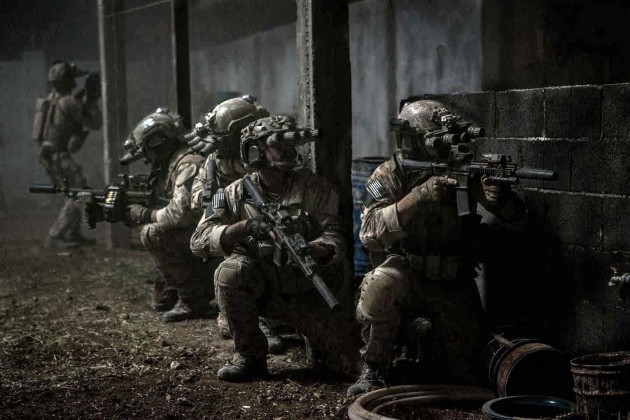“We’ll take 10-15 minutes?” asked Kathryn Bigelow and Mark Boal, the duo behind Zero Dark Thirty, the controversial film chronicling the hunt to kill Osama bin Laden.
“I could stay as much as 45 minutes,” replied Michael G. Vickers, the undersecretary of defense for intelligence and DOD’s highest-ranking civilian intelligence official. The conversation became the transcript at the heart of ZD30. Also, because of the extreme dearth of official documents released, this is the most illuminating and descriptive official U.S. government account of Operation Neptune Spear available. “Fabulous,” said Bigelow. “Dynamite,” said Boal.
To read the rest of the official documents on the raid that killed bin Laden, visit the National Security Archive’s Zero Dark Thirty file posted today.
The Department of Defense was forced to release this “extraordinary” transcript by a Freedom of Information Act lawsuit filed by Judicial Watch — where it has stayed largely unseen, 16 pages buried in a file of 153 pages of emails and memos. Judicial Watch did use Bigelow and Boal’s access to Vickers (and to then-CIA Deputy Director Michael J. Morell, who “gushed” over their previous film The Hurt Locker)and then-CIA Director Leon Panetta’s “full knowledge and full approval/support” of their access) to accuse the Obama administration of improperly giving “politically-connected film makers…extraordinary and secret access to bin Laden raid information.”
The Vickers transcript is more important than that, however. It reveals the deep uncertainty among intelligence analysts over whether it was actually bin Laden hiding in the Abbottabad compound, and it provides the most complete and specific inside history of the creation, planning, training, and approval of the U.S. strike that killed the man behind the September 11 attacks.
The Vickers interview was the genesis of the scene at the crux of Zero Dark Thirty. As Vickers tells it, two weeks before the raid, a “red team” composed of officers from the National Counterterrorism Center (NCTC), the CIA, and the DIA tried to “come up with alternative hypotheses” as to who was living at the compound. (One member of the red team had gotten married the day before and had to “ruin/cancel” his honeymoon.) The red team’s chief naysayer was dubbed “Mr. Forty Percent.”
Michael Morell believed the chance bin Laden was at Abbottabad was 60 percent; Vickers himself, and others in the NCTC, were “in the 80 camp.” Vickers never specifically mentions the analyst Bigelow has dubbed “Maya,” but he does reveal that the estimates ranged from “95 percent down to forty.” In the film, Maya informs her taken aback superiors that there is a 95 percent certainty that the Abbottabad shut-in is bin Laden.
Beyond the anecdotes, Vickers provides Bigelow and Boal with a complete “roadmap” of the raid’s evolution from conception to reality, giving them “a little bit of operational stuff, but more really policy, like how did we make the decision, the risks, that kind of stuff.” From his perspective, the preparation of Operation Neptune Spear had four primary phases.
In August of 2010, the CIA told Vickers about “the intelligence break and biggest secret of the US government”: that it was attempting to track Abu al-Kuwaiti, the courier who could lead to bin Laden. Vickers asked himself, “Who do I have to tell at this point?” He kept the circle small — “only eight or nine people” outside the CIA, the National Security Agency, and the National Geospatial-Intelligence Agency knew of the hunt. These included the president, the vice president, the national security advisor, the deputy national security advisor, the secretary of defense, the chairman and vice chairman of the Joint Chiefs of Staff, and the director for national intelligence.
Vickers recalls that they would “catch a glimpse” of al-Kuwaiti and think, “wholly [sic] crap we’re onto something” and then “oh man we lost him.”
Then, in January 2011 “the inner circle” began thinking, “okay we need to develop options.” Vickers, the head of Special Operations Command Admiral William H. McRaven, unnamed CIA operatives, and one unnamed Navy SEAL came up with “five or so” options. These included: raiding the compound with or without Pakistani assistance; invading with a larger or leaner force; using helicopters; or using a B-2 bomber; or (Vickers is extremely careful not to use the word “drone”) executing a “precision strike” or an “airstrike of one form but not [the B-2].”
Vickers describes the third phase as lasting from Valentine’s Day until mid-March 2011, when the strike options were refined in response to “‘Presidential guidance’ along the lines of ‘I want to do this sooner rather than later, probably unilateral…I want to keep my options open.’ Which meant several teams were planning several assaults at once.”
By the end of March, they had narrowed their options to two: an assault by helicopter or (presumably) a drone strike. The planners met with President Obama in mid-March and then swung into high gear. Their ranks swelled as they brought in all the “operators and planners” and “all sorts of staff” needed for “the ground operation.” The “Air [drone] Operation,” (which was not ultimately chosen) needed only “a handful of people.” A “full mission rehearsal” of the helicopter raid with “as realistic conditions as possible,” including a CIA mockup of the compound, was conducted “out West” in mid-April.
Vickers reports that the secretary of state was notified only “a couple of weeks before” the attack. The attorney general and representatives from the Department of Homeland Security and the FBI were notified only “the weekend of.” Finally, early the morning of May 1, according to Vickers, the president gave the green light: “an incredibly gutsy decision.”
For lifting the shroud of secrecy from the most important raid of the 21stcentury, Vickers has received an investigation from the Department of Defense Inspector General “on the question of whether Mr. Vickers provided classified information in an interview with the filmmakers.”
(Read the transcript of the background interview.)


Leave a Reply
You must be logged in to post a comment.